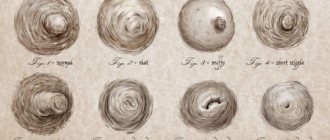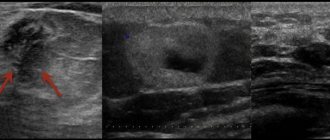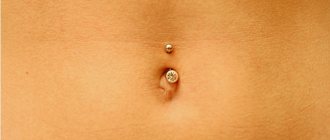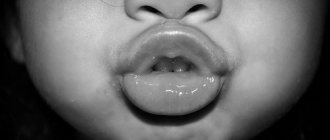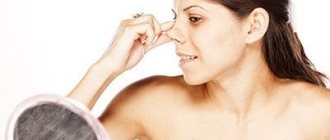A structural feature of the mammary glands, in which the nipples do not protrude above the surface of the isola, are pulled inward or are at the same level with it, requires correction. Inverted nipples can cause problems with breastfeeding; it is difficult for the baby to latch onto the nipple and hold it in the mouth. The nipple cavity becomes a reservoir of fat, sweat, secretions, and causes maceration of the areola. Maceration (softening) of the areola with an inverted nipple leads to skin damage and the development of an inflammatory process.
Causes of inverted nipples
The normal development of a girl’s genital organs, mammary glands, and milk ducts is the key to normal nipple development. Inverted nipples are often accompanied by underdevelopment of the genital organs, glands, and incomplete development of the milk ducts; Due to insufficient length of connective tissue and milk ducts, the nipple is pulled inward.
There are many reasons for the appearance of inverted nipples: it is not only a hereditary predisposition, but also some diseases (Paget's cancer, fat necrosis, ductal cystadenopapilloma and other diseases), wearing uncomfortable, tight underwear, and hypofunction of the gonads. Breast cancer also manifests itself as a symptom in the form of inverted nipple. If a normal nipple has changed its position and began to retract inward, you should contact a mammologist and undergo an examination. Such a change in the position of the nipple on one breast is considered an unfavorable symptom.
How to develop a flat nipple using therapeutic techniques
- Manual influence. The most popular method is to stimulate the inverted nipple with the thumbs of both hands, which are placed on different sides of the nipple and easily pulled in different directions. Movements are performed in the horizontal and vertical planes alternately, sessions are carried out at least twice a day. The effect is aimed at increasing the elasticity of tissues and eliminating “clamps” that cause deformation; The method works well if you need to correct a mild degree of inverted nipples.
- Stimulation during sex. Why not combine business with pleasure! The nipples are easily pulled, sucked and twisted, naturally, without “fanaticism” - any painful sensations are a signal to stop the “training”.
- Breast cups. Special devices made of soft synthetic material and consisting of convex disks with a hole in the center help to stretch the nipple. The nipple is placed into the hole, and the surrounding part of the cup presses on it and pushes it out of the mammary gland. There are cups on sale in different sizes (you need to choose them according to the parameters of the nipple), designed both for pulling out the nipples and for protecting sensitive or damaged nipples. Such devices are designed specifically for stretching the nipples of nursing mothers; they are recommended not to be worn all day: put on half an hour before feeding, and after feeding, remove and wash with warm water and soap to remove milk particles. If you follow these rules, you will be able to avoid the rash and irritation that women sometimes complain about when using this simple but very effective device.
- Breast pump. One of the most convenient and natural ways for nursing mothers to express milk and at the same time develop an inverted nipple. The breast is given to the baby as soon as the nipple “comes out” to the surface. A breast pump will also be useful after lactation is complete - it can be used as a trainer for inverted and flat nipples , that is, to solve the aesthetic part of the problem. Experts believe that electric devices provide a greater effect; in addition, they are more convenient to use.
- Syringe. This is a “budget” device for those who do not have a breast pump at hand. The principle of operation is the same - the nipple is pulled out with a vacuum. A large disposable syringe (10 ml) is cut off at the top (where the needle is) and the piston is moved ( the smooth edge, not the cut edge, should contact the areola ). They “put” the syringe chamber on the nipple and slowly pull the piston, as a result of which the nipple rushes into the resulting rarefied space. To remove the syringe, you need to release the pressure by pushing the piston in the direction of the nipple (but not all the way!). It should be remembered that a syringe is not a special device for pulling out the nipple, but in case of emergency you can use it !
- Corrector. This is a small cap worn on the chest, which is not noticeable under clothing, and therefore can be used at any time . To ensure a tight fit, the surface of the device and the skin are lubricated with a rich cream. After the corrector is installed, a syringe is inserted into the valve and the air is pumped out. Everything is done very smoothly and carefully so as not to cause any unpleasant sensations in the woman. As soon as the nipple “comes out” to the surface, the syringe is removed. Remove the corrector by lightly pressing the valve, because After air enters, the device is separated from the chest. It is recommended to wear the corrector for two hours a day at the beginning of use and subsequently do not increase the time of use beyond eight hours.
Correction of inverted nipples
In half of women, the inverted nipple begins to protrude above the surface of the areola during breastfeeding. Other women are recommended to have their nipples corrected. Surgical correction of the nipples is a surgical intervention that carries the risk of injury to the milk ducts and disruption of the integrity of the mammary ducts. This correction is carried out for women who do not plan pregnancy and breastfeeding in the future. For women of childbearing age, the use of conservative methods of nipple correction is recommended.
Symptoms of the disease
Identifying the clinical picture is not difficult. To determine the type of inverted nipple, you can carry out a simple manipulation: place your thumb and index finger on the areola at the base of the nipple from above and below and press slightly. There may be two scenarios for the development of events - either the nipple will peek out and rise above the areola, or not. In the second case, we have to talk about a truly inverted nipple.
The main manifestation of the syndrome is the presence of one or both nipples at the level of the areola or inside it. Often, with true nipple retraction, a woman is bothered by pain in the areola area, especially during a certain phase of the menstrual cycle, when the most pronounced engorgement of the glands is observed. If this pathology is identified by other specialists at our clinic, the patient is recommended to visit a mammologist to identify the root cause and further action.
Correction methods
The surgical correction method is carried out after a thorough examination of the woman’s health to exclude a malignant process in the mammary glands. The patient is explained the impact of the operation on her future ability to breastfeed, and receives confirmation that pregnancy is no longer planned. Dissection of the mammary gland ducts and nipple during correction leads to the impossibility of breastfeeding the child.
During surgery, surgeons use microsurgical techniques, but even in this case, the risk of damage to the mammary ducts and nipple is very high. The duration of nipple correction is from 30 minutes to one hour, the operation is performed under anesthesia, which can be either local or general. Nipple correction can be performed in conjunction with other operations to correct the volume and shape of the mammary gland.
Non-surgical correction is used to modify the nipples of women of childbearing age. With the help of a special vacuum attachment, which is attached to the nipple with a patch for the whole day, the nipple is pulled out over the nipple area. The condition of the nipple and surrounding area is regularly checked to avoid the development of cracks and damage. This correction is used for inverted nipples and as a preoperative preparation for tightly inverted nipples.
Why does such a defect occur?
The main causes of inverted nipples on women's breasts are:
- genetically determined feature of the anatomical structure of the mammary gland;
- soft tissue injuries of the chest;
- infectious and inflammatory diseases of the mammary glands;
- frequent pregnancies that have a hormonal effect on the anatomical structure of the breast;
- deficiency of sex hormones, leading to underdevelopment of the mammary glands during puberty.
In general, all of the above reasons lead to changes in the anatomical structure of the mammary gland. The nipples and the milk ducts passing through them are held in place by connective tissue cords. These cords go deep into the gland and are attached to the muscular-ligamentous base of the chest. If their length is insufficient (due to congenital characteristics or under the influence of diseases), then the nipple sinks inward and becomes retracted.
In addition, one more important reason should be highlighted: if the nipple of the mammary gland becomes inverted without any other changes in the surrounding tissues, this may be a manifestation of a malignant breast tumor. And such a symptom is a reason to visit a specialist. Not only her health and appearance, but sometimes her life, can depend on how quickly a woman addresses this problem to a doctor.
Postoperative period
After surgical correction of the nipple, the mammary gland swells, bruises appear, and the sensitivity of the nipple is greatly reduced. After some time, all unpleasant symptoms disappear, swelling disappears, and the stitches become almost invisible. Within a few weeks, nipple sensitivity is restored. The attending physician gives recommendations to the patient on behavior in the postoperative period: you should not visit saunas, steam baths, take a hot bath, be in the sun, and avoid heavy physical activity.
Video: nipple shape and breastfeeding
Attention! All of the above devices cannot be used during pregnancy to avoid miscarriage.
Symptoms of breast cancer in the circulatory system
If the tumor spreads through the blood vessels, then most often metastases are found in the following organs and tissues:
- bones. Symptoms: large metastases can disrupt the integrity of the periosteum, causing severe pain. Bone mineral density decreases, leading to fractures. A special case is a fracture of the vertebrae, which results in the so-called. compression (radicular)
- lungs. Symptoms: when they enter the lungs, tumor cells usually form several separate groups that form multiple metastases. Their development causes depression of pulmonary function, manifested by shortness of breath (dyspnea). When the bronchi are damaged, a painful dry cough develops (if nearby blood vessels rupture - cough
- brain. Symptoms: as metastases grow, they begin to put pressure on neurons, which causes their irritation (resulting in seizures) or partial shutdown (resulting in loss of mobility, loss of vision, sensitivity, etc.). Since the skull is a limited space, there comes a time when it becomes too crowded for neurons and tumor cells. A sign of this is headaches with gradually increasing intensity.
- liver. Symptoms: once in the liver, tumor cells begin to grow rapidly, destroying hepatocytes, as a result of which the level of transaminases in the blood sharply increases (this is clearly visible in a laboratory blood test). When the tumor compresses the bile ducts, bile accumulates, and the patient’s skin acquires a yellow tint.
Local cancer: symptoms
The clinical situation in this case can develop in four different directions:
1. The tumor is located in the middle part of the chest , in its glandular part. It is usually first discovered when a woman takes a bath or shower and notices a lump in one of her breasts. Immediate contact with a breast oncologist in such cases allows you to diagnose cancer even before the first clinically significant symptoms appear.
2.
The tumor is located near the nipple .
This localization of the tumor has two characteristic symptoms: deformation and retraction of the nipple (this is especially noticeable in comparison with the other nipple) and bloody discharge from the nipple. 3. The tumor has formed under the skin . In such cases, it manifests itself as a non-healing and unpleasant-smelling (due to bacterial infection) ulceration on the skin or “orange peel”, the appearance of which is caused by the accumulation of fluid due to compression of the lymphatic vessels.
4. The tumor lies deep in the thickness of the glandular tissue near the pectoral muscle, partially growing into it. A sign of this location of the tumor is a distinct asymmetrical shape in a bent position at the waist.
Check the price with a specialist
Breast cancer by lymphatic system
Spreading through the lymphatic vessels, the tumor can penetrate the axillary lymph nodes. In this case, the following symptoms are observed:
- enlargement of lymph nodes up to clearly palpable nodules
- accumulation of cancer cells in the armpit area
Less commonly, the tumor may migrate through the internal thoracic duct, which runs under the breastbone. Symptoms: since the tumor affects deep-lying lymph nodes, it can only be detected using instrumental diagnostic methods .
An even rarer case is a lesion of the supraclavicular lymph node, which manifests itself as a palpable lump in the area between the lower part of the neck and the upper rib. As it grows further, it can put pressure on the brachial plexus, causing loss of sensation in the fingers or shooting pain in the shoulder.
How the quality of medications affects the cure for breast cancer
The treatment protocol for breast cancer includes chemotherapy and sometimes hormonal and targeted drugs. At the same time, the quality of drugs is crucial for the prognosis of the disease. To avoid counterfeiting, it is best to purchase drugs for cancer treatment in Israel.
- In Israel you will not be sold counterfeit medicines.
The Israeli Ministry of Health is the guarantor of the authenticity and high quality of medicines. It organizes inspections of pharmacies and control purchases of drugs. At the same time, pharmacies and pharmacists bear liability (including criminal liability) for the sale of low-quality drugs. - It does not take long for new drugs to be approved in Israel.
Licensing of drugs in this country is organized in such a way that all effective drugs appearing in the world are quickly licensed and introduced into widespread clinical practice. - The Israeli company TEVA is a leader in the global pharmaceutical industry.
Its products are used in 60 countries.
How normal is it to have inverted nipples?
Between 2 and 10% of women have at least one inverted nipple
Inverted nipples are not an anatomical abnormality and are usually neither a cause nor a consequence of serious medical conditions. In general, doctors do not think that people need any treatment in such cases.
However, therapy may be needed if the cause of sunken nipples is a serious health problem, such as inflammation or cancer in the breast.
According to American experts, from 2 to 10% of women have at least one inverted nipple. Men can also develop this feature.
Some people find that inverted nipples make breastfeeding difficult. In this case, stimulation may cause partial straightening of a flat or recessed nipple, and if the nipple is severely indented, the baby may need to capture the full areola during feeding. Some women find that their nipples become less recessed into their breasts after breastfeeding.
Types of nipple retraction
There are 2 types of deviations.
Hiding nipples. In normal condition they do not protrude from the areola. But when the breasts are stimulated (sexually or while feeding a child), they stretch.
Inverted nipples. Recession of the nipples is permanent. Their position does not change during stimulation.
Note: There is an external sign by which anomalies of these types can be distinguished from each other. Hiding nipples are characterized by the fact that their edges are slightly visible above the skin, and there is a receding fold in the center. Inverted ones sink completely and have a smooth surface.
How can I purchase Israeli-made medicines?
- After examination in Israel.
If you undergo diagnostics at the Ichilov Cancer Center, the doctor will prescribe medications for you, which you can purchase at an Israeli pharmacy. - In the country where the patient lives.
The telemedicine program developed at the Ichilov Cancer Center allows a patient from abroad to receive a video consultation with an Israeli doctor and a treatment protocol without leaving home. At the patient’s request, the oncology center will send him the prescribed medications (home delivery is possible).
Indications and contraindications
The final argument in favor of surgery is the inclusion of the diagnosis or symptoms of the applicant in the list of medical indications. It covers:
- loss of the nipple;
- loss of the entire areola, which occurs with a mastectomy;
- desire to change the current shape due to aesthetic unattractiveness;
- neutralization of defects or congenital deformities such as bifid nipple;
- breast lifting, which involves reducing the diameter of the areola.
At the same time, the doctor is obliged to check whether the patient has hidden contraindications. Some of them belong to the relative camp, which means a ban on performing the operation only temporarily.
Under more favorable circumstances, the contraindication is removed. Basic prohibitions include:
- pregnancy, lactation period;
- processes caused by infections;
- suspicions of oncological neoplasms of a benign and malignant nature;
- problems with normal blood clotting;
- predisposition to the formation of keloid-type scars.
Individual intolerance to the active ingredients of anesthesia and related medications is taken into account separately.
Surgical approach
Due to the relatively low percentage chance of a successful outcome without recurrence, many patients choose surgery over alternative measures. This procedure is prescribed even to men, although they are extremely rarely treated with such a diagnosis.
Particularly difficult is reconstruction after a mastectomy, when it is necessary to create the nipple almost anew. This requires professionalism and specialist experience. A preliminary detailed consultation will be required to calculate the risks, as well as forecasts of success.
It is important to pay attention to the preliminary stage. The doctor is obliged to study the medical history in detail and also select the ideal anesthesia format. If necessary, an allergy test is performed at the preparatory stage to eliminate the risk of developing anaphylactic shock.
If we are talking about a minor intervention, then it is possible to use local anesthesia. But if the doctor has to work for a long time, restoring tissue at a deep level, then it is better to take advantage of general anesthesia. The patient will also need to undergo a laboratory blood test.
